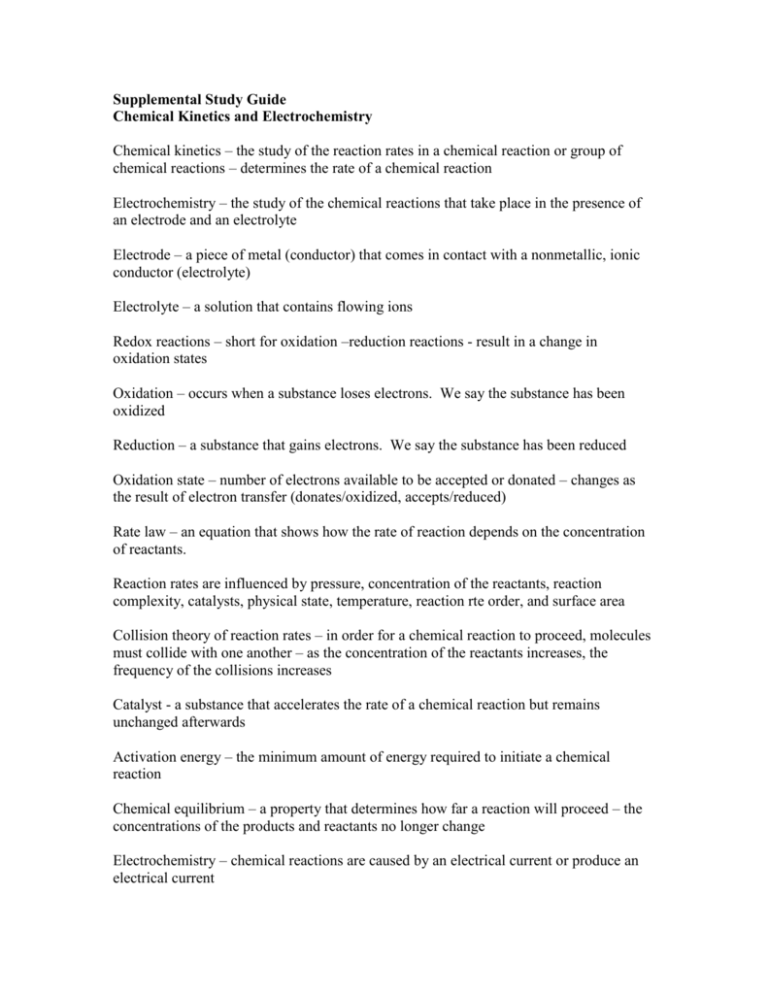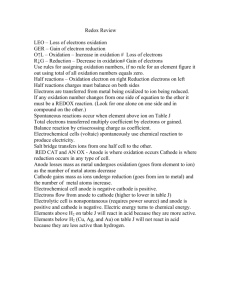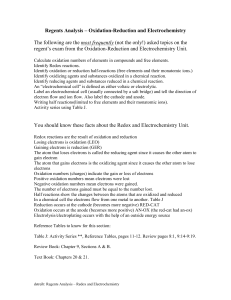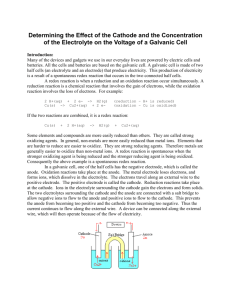Kinetics Study Guide - Moore Public Schools
advertisement

Supplemental Study Guide Chemical Kinetics and Electrochemistry Chemical kinetics – the study of the reaction rates in a chemical reaction or group of chemical reactions – determines the rate of a chemical reaction Electrochemistry – the study of the chemical reactions that take place in the presence of an electrode and an electrolyte Electrode – a piece of metal (conductor) that comes in contact with a nonmetallic, ionic conductor (electrolyte) Electrolyte – a solution that contains flowing ions Redox reactions – short for oxidation –reduction reactions - result in a change in oxidation states Oxidation – occurs when a substance loses electrons. We say the substance has been oxidized Reduction – a substance that gains electrons. We say the substance has been reduced Oxidation state – number of electrons available to be accepted or donated – changes as the result of electron transfer (donates/oxidized, accepts/reduced) Rate law – an equation that shows how the rate of reaction depends on the concentration of reactants. Reaction rates are influenced by pressure, concentration of the reactants, reaction complexity, catalysts, physical state, temperature, reaction rte order, and surface area Collision theory of reaction rates – in order for a chemical reaction to proceed, molecules must collide with one another – as the concentration of the reactants increases, the frequency of the collisions increases Catalyst - a substance that accelerates the rate of a chemical reaction but remains unchanged afterwards Activation energy – the minimum amount of energy required to initiate a chemical reaction Chemical equilibrium – a property that determines how far a reaction will proceed – the concentrations of the products and reactants no longer change Electrochemistry – chemical reactions are caused by an electrical current or produce an electrical current Electrochemical cell – a device capable of producing electric current from energy released by a redox reaction - differing electrode potentials help drive the reactions Galvanic cells – the anode loses electrons (corrodes) through the electrolyte to the cathode – oxidation takes place at the anode – reduction takes place at the cathode – electrons flow from the anode to the cathode in a solution (electrolyte) – the metals react in the form of half reactions resulting in a difference of electrons which produces an electric current Law of mass action – applies to single-step reactions – the speed of a chemical reaction is proportional to the amount of the reacting substances Single step reaction – proceed from start to finish without an intermediate step (another product that is formed on the way – treated as an additional reaction) Reaction mechanism – a step-by-step reaction pathway Arrhenius equation – expresses temperature dependency of a chemical reaction rate where K is the reaction rate constant. Ea is the activation energy, measured in joules/mole. R is the gas constant (0.08205746 Latm K-1 mol-1). T is the temperature, measured in kelvins (K). A is the frequency factor (specific to reaction). Chemical Equilibrium Zero order rate reaction –a valid rate law - the reaction rate will not increase by increasing the concentration of the reactants – does not depend on the concentration of the reactants r=k where r is the reaction rate, k is the reaction rate coefficient, expressed as concentration/time First order rate reaction – a valid rate law - depends on the concentration of only one reactant r =k[X] where k is the first order rate constant, expressed as units of time-1. [X] is the concentration of one reactant (first order), expressed as mol/L Second order rate laws – are dependent on the concentrations of one second-order reactant or two first order reactants r = k[X][Y] R = k[X]x[Y]y Law of conservation of energy – energy can neither be created or destroyed











